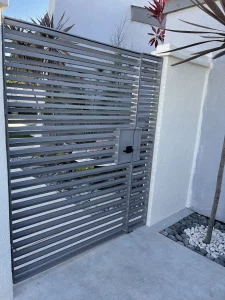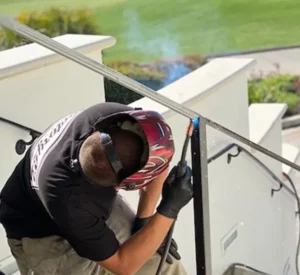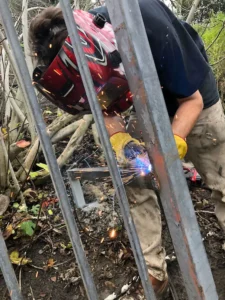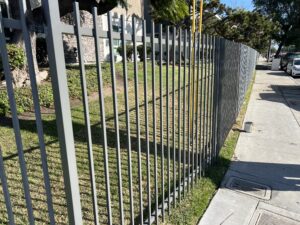Welding is an intricate process requiring skill and a thorough understanding of the materials. The choice of metal can significantly impact the welding process’s quality, durability, and efficiency. At Smith Welding & Fabrication, we understand the importance of selecting suitable metals for each project. In this guide, we’ll explore the best metals for welding, their properties, and their ideal applications.
Introduction to Welding Metals
Welding is a fabrication process that joins materials, usually metals, by causing coalescence. This is often done by melting the workpieces and adding a filler material to form a strong joint upon cooling. The type of metal used in welding is crucial, as it affects the welding technique, the equipment required, and the quality of the weld.
1. Steel
Carbon Steel: Carbon steel is one of the most commonly welded metals. Its versatility, strength, and cost-effectiveness make it a popular choice in various industries, including construction, automotive, and manufacturing.
Advantages:
- Strength: Carbon steel offers excellent strength and durability.
- Cost-Effective: It is relatively inexpensive compared to other metals.
- Versatile: Suitable for various welding techniques, including MIG, TIG, and arc welding.
Disadvantages:
- Corrosion: Prone to rust without proper treatment.
- Heat Distortion: Can warp under high heat if not managed correctly.
Low-Alloy Steel: Low-alloy steels are similar to carbon steels but contain additional elements like nickel, chromium, and molybdenum, enhancing their mechanical properties and corrosion resistance.
Applications:
- Structural components
- Machinery parts
- Pipelines
Stainless Steel: Stainless steel is another type widely used in various applications due to its excellent corrosion resistance and strength.
Advantages:
- Corrosion Resistance: Stainless steel is resistant to rust and corrosion, making it ideal for environments exposed to moisture and chemicals.
- Strength and Durability: It offers high strength and durability.
- Aesthetic Appeal: Stainless steel maintains a clean, polished, aesthetically pleasing appearance.
Disadvantages:
- Cost: Stainless steel is more expensive than carbon steel.
- Welding Challenges: Requires precise control to avoid distortion and maintain properties.
Applications:
- Food processing equipment
- Medical instruments
- Marine applications
2. Aluminum
Aluminum is a lightweight, versatile metal with excellent corrosion resistance, making it popular in the aerospace, automotive, and construction industries.
Advantages:
- Lightweight: Reduces the overall weight of structures and components.
- Corrosion Resistance: Naturally, it forms a protective oxide layer.
- Thermal Conductivity: Efficient at dissipating heat.
Disadvantages:
- Welding Difficulty: Requires specialized techniques and equipment.
- Cost: More expensive than steel.
Applications:
- Aircraft and automotive parts
- Frames and structural components
- Heat exchangers
3. Titanium
Titanium is known for its exceptional strength-to-weight ratio and corrosion resistance, making it ideal for high-performance and critical applications.
Advantages:
- Strength-to-Weight Ratio: High strength with low density.
- Corrosion Resistance: Excellent resistance to various corrosive environments.
- Biocompatibility: Safe for medical implants.
Disadvantages:
- Cost: Expensive and requires specialized welding techniques.
- Reactivity: Highly reactive at high temperatures.
Applications:
- Aerospace components
- Medical implants
- Marine Hardware
4. Copper and Copper Alloys
Copper and its alloys, such as brass and bronze, are prized for their electrical conductivity and corrosion resistance.
Advantages:
- Electrical Conductivity: Excellent conductor of electricity.
- Corrosion Resistance: Resistant to various forms of corrosion.
- Thermal Conductivity: Efficient at conducting heat.
Disadvantages:
- Softness: Softer than other metals, which can impact durability.
- Cost: It can be expensive, but it is exceptionally pure copper.
Applications:
- Electrical wiring and components
- Plumbing
- Heat exchangers
5. Nickel Alloys
Nickel alloys are known for their high strength, heat, and corrosion resistance, making them suitable for extreme environments.
Advantages:
- Heat Resistance: Maintains strength at high temperatures.
- Corrosion Resistance: Resistant to oxidation and corrosion.
- Durability: High durability in harsh environments.
Disadvantages:
- Cost: Expensive and requires specialized welding techniques.
- Welding Challenges: Requires precise control to avoid cracking.
Applications:
- Chemical processing equipment
- Gas turbines
- Power generation components
Welding Techniques for Different Metals
Each type of metal may require specific welding techniques to ensure the best results. Here are some of the most commonly used welding methods and their compatibility with different metals.
MIG Welding (Metal Inert Gas)
MIG welding is a versatile and widely used technique for welding carbon steel, stainless steel, and aluminum. It involves feeding a continuous wire electrode through a welding gun, which melts and joins the metal pieces.
Advantages:
- Speed: Fast welding process.
- Ease of Use: Suitable for beginners and automated welding.
- Versatility: Can weld various metals and thicknesses.
Applications:
- Automotive Repair
- Fabrication of metal structures
- Manufacturing
TIG Welding (Tungsten Inert Gas)
TIG welding produces high-quality, precise welds. It uses a non-consumable tungsten electrode and is suitable for welding stainless steel, aluminum, and titanium.
Advantages:
- Precision: Produces clean and high-quality welds.
- Versatility: Can weld thin and thick materials.
- Control: Allows precise control over the welding process.
Applications:
- Aerospace
- Automotive
- Art and sculpture
Stick Welding (Shielded Metal Arc Welding)
Stick welding is a traditional method that uses a consumable electrode coated in flux. It is suitable for welding carbon steel and low-alloy steel.
Advantages:
- Simplicity: Simple equipment setup.
- Portability: Can be used in various environments, including outdoors.
- Versatility: Works well on rusty or dirty metals.
Applications:
- Construction
- Repair and maintenance
- Pipelines
Flux-Cored Arc Welding (FCAW)
Flux-cored arc welding is similar to MIG welding but uses a special tubular wire filled with flux. It is effective for welding carbon, low-alloy, and stainless steel.
Advantages:
- Speed: Fast and efficient welding process.
- Versatility: Suitable for thick materials and outdoor welding.
- Penetration: Provides deep penetration for solid welds.
Applications:
- Heavy equipment repair
- Shipbuilding
- Structural steel
Factors to Consider When Choosing Welding Metals
Selecting the suitable metal for welding involves considering several factors, including:
- Application Requirements: Understand the specific requirements of the application, such as strength, weight, corrosion resistance, and aesthetic appeal.
- Welding Technique: Different metals may require specific welding techniques. For example, TIG welding is preferred for aluminum and stainless steel, while MIG welding is commonly used for carbon steel.
- Budget: Consider the cost of materials and the associated welding processes. While some metals may be more expensive, they offer long-term benefits in terms of durability and maintenance.
- Environment: Consider the operating environment. For example, stainless steel and aluminum are ideal for corrosive environments, while carbon steel suits less demanding conditions.
- Mechanical Properties: Consider the metal’s mechanical properties, such as tensile strength, ductility, and hardness, to ensure it meets the application’s demands.
- Thermal Conductivity: Metals with high thermal conductivity, like aluminum, require more heat input and efficient heat management during welding.
Common Welding Challenges and Solutions
Welding different metals can present various challenges. Here are some common issues and their solutions:
Distortion: High heat input during welding can cause metals to warp or distort. To minimize distortion, use proper welding techniques, control heat input, and employ fixtures to hold the metal in place.
Cracking: Certain metals, like nickel alloys and stainless steel, are prone to cracking. Preheating the metal, using appropriate filler materials, and controlling cooling rates can help prevent cracking.
Porosity occurs when gas pockets form in the weld, weakening the joint. To reduce porosity, ensure proper shielding gas coverage, clean the metal surfaces, and avoid excessive heat.
Incomplete Fusion: Incomplete fusion happens when the weld metal does not fully bond with the base metal. Proper technique, adequate heat input, and correct electrode angle can help achieve complete fusion.
Conclusion
At Smith Welding & Fabrication in Orange County, CA, we specialize in working with various metals to meet our clients’ diverse needs. Whether you need a durable steel structure, a lightweight aluminum component, or a corrosion-resistant stainless steel part, our expert team can deliver high-quality welding solutions tailored to your specific requirements.
By understanding the properties and applications of different metals, you can make informed decisions and achieve optimal results in your welding projects. For more information on our services and how we can help with your next project, please contact Smith Welding & Fabrication today.







